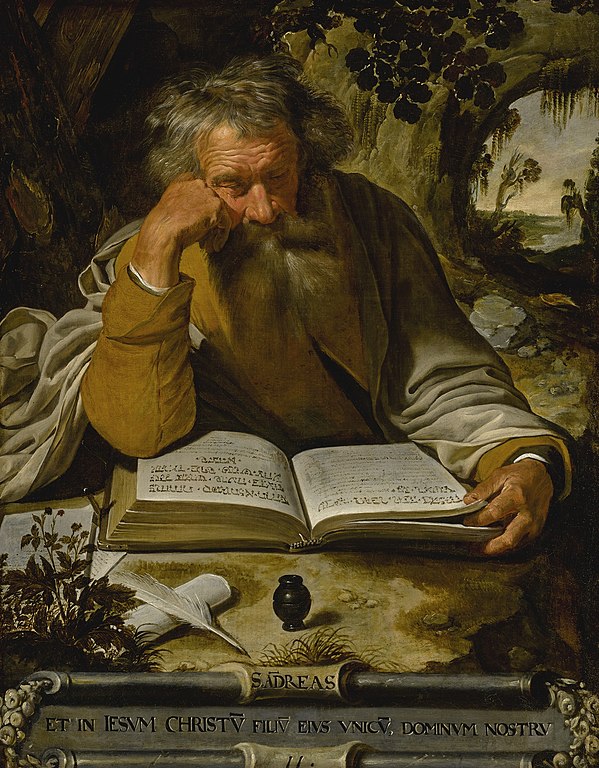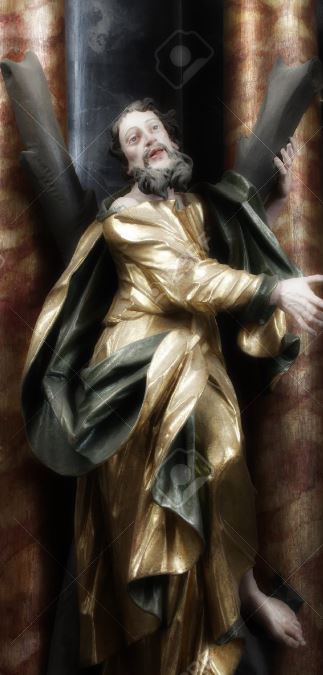Feast of St Andrew, Apostle of Christ, Martyr – 30 November
Saint Andrew was the brother of the Apostle Peter and like his brother was born in Bethsaida of Galilee (where the Apostle Philip was also born). While his brother would eventually overshadow him as the first among the apostles, it was Saint Andrew, a fisherman like Peter, who (according to the Gospel of John) introduced Saint Peter to Christ.
St Andrew was a fisherman who lived in Galilee during the time of Jesus. He followed John the Baptist and listened to his teachings. One day, John saw Jesus walking along the road. John said to his followers, “Behold the Lamb of God.” He told his followers to go and talk to Jesus. He wanted them to know that Jesus was the One for whom they had been waiting. Andrew and another disciple followed Jesus and spent an afternoon with him. Early the next day Andrew found Simon Peter, his brother and told him, “We have found the Messiah.”
Both men gave up their work as fishermen to become apostles of Jesus. Andrew was one of the first to be called. He seemed to take delight in bringing others to Jesus. 
Andrew was the one who told Jesus about the little boy who had the loaves of bread and the fish, the beginning of a meal that fed more than five thousand people.
It was Andrew and Philip whom the Greeks approached when they wanted to see Jesus. These events indicate that Andrew was a man who was easy to approach, a man you could trust.
Like the other apostles, Andrew became a missionary. He preached about Jesus in the area around the Black Sea. Tradition tells us he preached in northern Greece, Turkey and Scythia (now the southern part of Russia).
Tradition places Saint Andrew’s martyrdom on 30 November of the year 60 (during the persecution of Nero) in the Greek city of Patras. A medieval traditional also holds that, like his brother Peter, he did not regard himself as worthy of being crucified in the same manner as Christ and so he was placed on an X-shaped cross, now known (especially in heraldry and flags) as a Saint Andrew’s Cross. The Roman governor ordered him bound to the cross rather than nailed, to make the crucifixion and thus Andrew’s agony, last longer.
Because of his patronage of Constantinople, Saint Andrew’s relics were transferred there around the year 357. Tradition holds that some relics of Saint Andrew were taken to Scotland in the eighth century, to the place where the town of S. Andrews stands today. In the wake of the Sack of Constantinople during the Fourth Crusade, the remaining relics were brought to the Cathedral of Saint Andrew in Amalfi, Italy. In 1964, in an attempt to strengthen relations with the Ecumenical Patriarch in Constantinople, Pope Paul VI returned all relics of Saint Andrew that were then in Rome to the Greek Orthodox Church.
Every year since then, the Pope has sent delegates to Constantinople for the feast of Saint Andrew (and, in November 2007, Pope Benedict himself went), just as the Ecumenical Patriarch sends representatives to Rome for the 29 June feast of Saints Peter and Paul (and, in 2008, went himself). Thus, like his brother Saint Peter, Saint Andrew is in a way a symbol of the striving for Christian unity.
St Andrew’s Feast takes pride of place in the Liturgical Calendar, for in the Roman Catholic calendar, the liturgical year begins with Advent and the First Sunday of Advent is always the Sunday closest to the Feast of Saint Andrew. Though Advent can begin as late as 3 December, Saint Andrew’s feast, today is traditionally listed as the first Saint’s day of the liturgical year, even when the First Sunday of Advent falls after it—an honour commensurate with Saint Andrew’s place among the apostles The tradition of praying the Saint Andrew Christmas Novena 15 times each day from the Feast of Saint Andrew until Christmas flows from this arrangement of the calendar.
The name “Andrew” is a Greek name meaning “courageous” or “manly.” St Andrew lived up to his name.
St Andrew, pray that we live up to the name “Christian”!
St Andrew’s Patronages are here:
https://anastpaul.com/2018/11/30/saint-of-the-day-30-november-st-andrew-apostle-of-christ-martyr/


This reminds me of another matter. Oh beautiful and wise darling, I read a lot of historical fiction set in medieval times and they would tell time by the angelus, and other similar times the Church would ring. And, for a calendar the Michealmas, Lammas, and others. I would love to find a complete comparison of those as they relate to the calendar we use. Where should I start my search?
LikeLiked by 1 person
I think probably a first port of call would be catholicculture.com – try there first and let me know. If not, I will do some research.
LikeLike